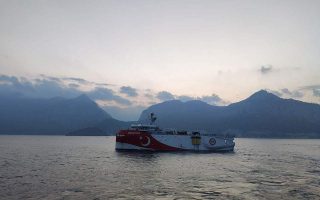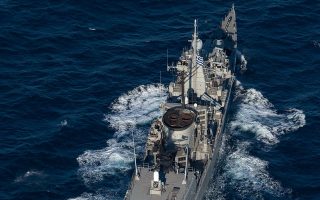The story of an innovative navy ‘mafia’

Could anyone imagine that Hellenic Navy officers would follow the written advice of an anonymous top Italian mafioso to execute one of the most critical missions of their careers? Or that in their effort to activate our most advanced nautical weapons, navy officers would manage to come up with solutions to serious technological issues at a cost of less than 3% of the amount demanded by foreign suppliers?
In Greek Kathimerini on November 8, 2020, reporter Vassilis Nedos described crucial aspects of the Type 214 submarines’ odyssey and how they ended up being the superweapons in the conflict against Turkey, even though, until recently, they had been mocked as the “listing submarines.”
Nedos’ article noted that one could write a separate history of the navy personnel who innovated in order to solve the huge problems that kept these submarines from being completed for years.
This article is the story of that storied navy team which applied strange and novel management principles that the Mafia itself would envy. It negotiated with unions, outsmarted US and German tech giants and took unprecedented initiative on a Greek and global scale in order to finally succeed in activating the Type 214 submarines, saving the Greek state tens of millions of euros.
It is 2013. Work at Hellenic Shipyards has ground to a halt. The three Type 214 submarines and the one Type 209, under overhaul, are locked in, their completion state much less than the officially acknowledged 80%. Whatever has been completed has been completed by Hellenic Shipyards under the direction of German shipbuilding firm Howaldtswerke-Deutsche Werft (HDW). German and US firms involved in the construction of the four submarines are either AWOL or demanding tens of millions of euros to help. The shipyard workers are unemployed and owed months of back pay and the unions are pushing for exorbitant salaries, mostly for some of their favorites, in the midst of a financial crisis.
Under these desperate conditions, the navy leadership decides to take matters into its own hands and is given the OK by the civilian leadership to take over Hellenic Shipyards to complete the construction of the four subs. Responsibility for this historic mission falls upon the then commander of the Skaramangas Naval Detachment (SND), an enlightened officer who proved to have magical powers in managing both personnel and resources.
From its establishment in 1987, SND’s exclusive role was to monitor Hellenic Shipyards’ progress in completing the navy’s procurement programs and make sure the contractual terms were followed. Overnight, SND morphed from a simple observer and inspector at the shipyards to manager of all their operations and personnel.
The first concern of the SND commander was to choose a “dream team” of line and non-commissioned officers from the Submarine Command who would be responsible for organizing and managing the construction program. This was a wise decision, because no one knows the submarines – and cares for them – more than those who use them and the Submarine Command is one of the most demanding in its training and contains some of the navy’s best professionals, like the SND commander himself.
Next, the commander and his team had to ensure the adequate staffing of the shipyard by rehiring more than 700 laid-off managers, administrative staff and workers. Here, however, there was the potential for a culture clash, because naval officers have great experience in managing personnel, but within the framework of the rules and regulations of the Hellenic Navy. How could they manage hundreds of civilian employees and the unions?
The commander realized he was facing an unprecedented problem, which demanded an unprecedented solution. His solution included unusual management methods and practices, taking advice even from the Mafia. Specifically, the commander turned for help to the classical management handbook “The Mafia Manager,” principles of corporate management written by a high-ranking Italian-American mafioso, which he recommended that all the officers in his team read. The story of how the team applied the book’s principles is unique and could easily form the material of a movie script.
Where the navy team really triumphed was in managing the technological challenges of the construction. The team was split into 10- to 20-strong teams per submarine, each charged with leading and coordinating the workers’ teams on the heaviest building works. Each team also contained line and non-commissioned officers highly specialized in electronics, who undertook the most sensitive electronic works themselves, so they could be in complete charge of the management of each vessel’s sophisticated operational systems.
The naval team realized very quickly that there were huge issues with supply delays in replacement parts as well as overcharging. For example, a German firm asked for €60,000 for a power supply that would take months to deliver. Finally, the navy technicians managed to build it themselves in less than an hour, with components bought at local stores for less than €1,500. That is, for 2.5% of the cost charged by the Germans.
There were instances, however, when, after tinkering with very sensitive electronics, the SND had to ask a big US military equipment producer for help. The Greek technicians thought they had solved the problem, but, given the complexity of the system, it was important to get the builder’s opinion. When the US technician examined the component, he could not believe the ingenuity of the Hellenic Navy team and took pictures to show his colleagues. “This has never happened,” he said. “It is the first time I’ve seen this component opened; normally, once it leaves the factory, we never open it again.”
These small, successive triumphs boosted the morale of the navy officers, who were working at an exhausting pace. But it was worth the effort, since they saw daily that they had created a well-oiled system that identified problems and solved them immediately, and this experience was stored to solve future problems faster. Many described the experience as the best and most satisfying years of their long navy service careers.
Finally, with the help of the shipyard technicians, the naval team managed to activate the first Greek Type 214 submarine and the overhauled Type 209 sub within six months. The rest followed shortly afterward, saving the Greek state tens of millions of euros.
Besides the submarines, this process had many benefits.
At this moment, the Submarine Command probably has the best technologically trained line and non-commissioned officers in the world in this very specialized subject. One of them, still a submarine commander, was responsible for the activation of the electronics systems of all three Type 214 subs. This particular officer and his team solved the electronic systems’ compatibility issues that the builders themselves could not. If they had worked in the private sector, the young officer and his team would get huge bonuses. What they did was take over essentially inactive metal husks that had cost billions and turned them into vessels respected and feared by the Turkish Navy.
The work of those involved was recognized by the Hellenic Navy’s top brass. Some were rewarded by the commander of the service and most were put into critical posts so that they continued to serve using the knowledge, the experience and, above all, the flexibility and outside-the-box thinking that they acquired while trying to activate the submarines.
The knowledge from this unique experience has been transferred to the crews of all Greek submarines and the Submarine School to be disseminated to all future submarine officers.
Success, though, has been bittersweet, in that capable officers from the navy, but also the air force and army, are increasingly turning to the private sector. Officers from the submarine activation program – and not just that program – have joined the domestic and global private market. Of course I don’t know how we could solve this. What I do know is that these people are our ultimate deterrent against an ever-more-aggressive Turkey, so solving this brain drain should be an immediate priority.
The “mafia man” himself, the former SND commander who organized it all, rose to the rank of vice admiral and retired in September 2020, aged 57. Maybe he could be put at the helm of a big state agency instead of staying at home? Maybe his next mission ought to be to set up and organize a special state agency that could train and use similarly capable and motivated people to those of the submarine “dream team.” They could be our real superweapons.
Revolutionary technology
Submarines are divided into nuclear and conventional. Nuclear submarines have essentially unlimited autonomy: They can remain submerged for as long as is operationally desirable – for months, even, in theory, years.
By contrast, conventional submarines, like the six older Type 209 ones, use batteries that must be charged every few days. To charge them, the submarine must be near the surface to be able to use its snorkel to let air in. The air is needed to operate the battery chargers. During this operation, the submarines are vulnerable.
The overhauled Type 214 submarines and the newer Type 214s are fitted with a revolutionary technology that allows them to remain underwater for over a month, as we saw in the recent tension with Turkey. The technology works as the reverse of electrolysis, in which a current is applied to two electrodes to separate the water into its constituent elements, hydrogen and oxygen. The Type 214 subs combine hydrogen and oxygen to produce water and electricity, which charges their batteries. This procedure is quiet and anaerobic – that is no outside air is needed. Thus, in combination with our crews’ competence, the submarines can remain undetected.
Nikolas Katsimpras has been a lecturer on Columbia University’s Negotiation and Conflict Resolution program since 2014. He is an independent conflict analysis / strategy consultant and a former Hellenic Navy officer.





